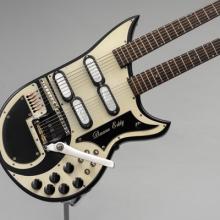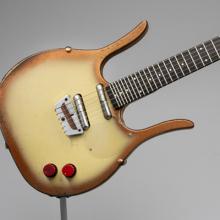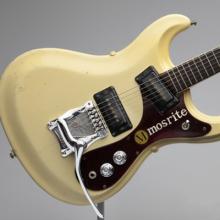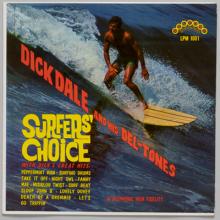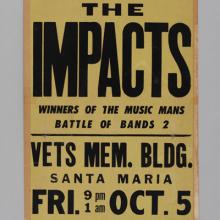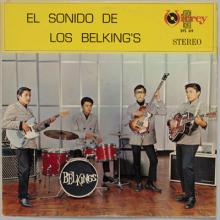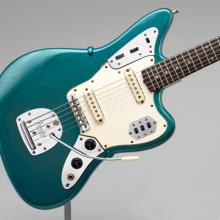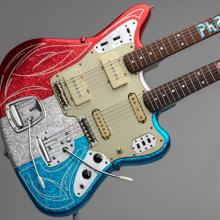Terminal 2












Howard custom double-neck guitar 1960
played by Duane Eddy
Howtronics | Phoenix, Arizona
Courtesy of Deke Dickerson
L2020.1903.002a
Duane Eddy
Duane Eddy (b. 1938) is one of the first and most influential instrumental rock ’n’ roll guitarists. Often referred to as “The King of the Twangy Guitar,” Eddy has inspired innumerable musicians and groups with his deceptively simple playing and signature guitar tone. Duane Eddy made his breakthrough in 1958 when he scored a #6 hit on the Billboard charts with “Rebel-Rouser.” The song was written and arranged by Eddy and producer Lee Hazlewood (1929–2007) while recording in the studio and featured a distinctive, echo-driven guitar tone.
 To achieve the unique sound on “Rebel-Rouser,” Duane Eddy played a Gretsch 6120 guitar through a DeArmond tremolo effect and a high-powered Magnatone amplifier. Hazlewood and studio-owner Floyd Ramsey (1926–2008) then fed the recorded guitar track into a speaker and microphone installed in a 2000-gallon water tank they had placed in the parking lot as an echo chamber. On later recordings, Eddy alternated between his trusty Gretsch and a six-string Danelectro bass guitar, and in 1960 he commissioned specialty guitar and amplifier maker Tom “Howard” McCormick (active 20th c.) to build a double-neck guitar with both attributes. Although the guitar played well, it was heavy and the electrical system was prone to feedback. Eddy retired the guitar after an appearance on American Bandstand and a few other live performances.
To achieve the unique sound on “Rebel-Rouser,” Duane Eddy played a Gretsch 6120 guitar through a DeArmond tremolo effect and a high-powered Magnatone amplifier. Hazlewood and studio-owner Floyd Ramsey (1926–2008) then fed the recorded guitar track into a speaker and microphone installed in a 2000-gallon water tank they had placed in the parking lot as an echo chamber. On later recordings, Eddy alternated between his trusty Gretsch and a six-string Danelectro bass guitar, and in 1960 he commissioned specialty guitar and amplifier maker Tom “Howard” McCormick (active 20th c.) to build a double-neck guitar with both attributes. Although the guitar played well, it was heavy and the electrical system was prone to feedback. Eddy retired the guitar after an appearance on American Bandstand and a few other live performances.
Duane Eddy on American Bandstand 1960
Courtesy of Deke Dickerson
R2020.1903.002c
♪ Listen to the music: “Rebel-Rouser” Duane Eddy and The Rebels, 1958
Danelectro Guitarlin 1958
played by Link Wray
Danelectro Corporation | Red Bank, New Jersey
Courtesy of Deke Dickerson
L2020.1903.001a
Link Wray
 Link Wray (1929–2005) was the archetypal rock ‘n’ roll guitarist, a seemingly mythical figure whose sound was shaped by a series of significant life events. Born into poverty in Dunn, North Carolina, Fred Lincoln Wray, Jr. was nicknamed “Link” by his mother, Lillian Mae, to distinguish the young boy from his father. A childhood bout with measles damaged Link’s hearing and eyesight, and years later he lost a lung after contracting tuberculosis while serving in the Korean War with the Army Medical Corps. Wray recalled, “I’ve got bad eyes and I can’t hear real good so I had to play loud ‘cause I couldn’t play clean…The only reason I was doing instrumentals was because I couldn’t sing.”
Link Wray (1929–2005) was the archetypal rock ‘n’ roll guitarist, a seemingly mythical figure whose sound was shaped by a series of significant life events. Born into poverty in Dunn, North Carolina, Fred Lincoln Wray, Jr. was nicknamed “Link” by his mother, Lillian Mae, to distinguish the young boy from his father. A childhood bout with measles damaged Link’s hearing and eyesight, and years later he lost a lung after contracting tuberculosis while serving in the Korean War with the Army Medical Corps. Wray recalled, “I’ve got bad eyes and I can’t hear real good so I had to play loud ‘cause I couldn’t play clean…The only reason I was doing instrumentals was because I couldn’t sing.”
Link Wray’s heritage also played an important part in his music. Wray’s mother was Shawnee, and Link proudly referenced his mother and his Native American ancestry throughout his career, evidenced in part by the loving, instrumental ballad “Lillian.” His greatest success came in 1958 when “Rumble” peaked at #16 on the Billboard charts, although it was quickly banned by some radio stations for its “suggestive” title. To achieve the distorted guitar sound on “Rumble,” Wray played a 1953 Gibson Les Paul through a Premier Model 71 amplifier that he modified by poking holes in the two smaller Jensen speakers. This created a now-commonplace effect known as distortion—the first documented use on a record—while the Premier’s built-in tremolo added the warbling echo. The Danelectro Guitarlin “Longhorn” shown here dates to Wray’s early stint with Epic Records and is shown on the cover of the group’s first LP record, Link Wray & The Wraymen.
Link Wray & The Wraymen 1960
Link Wray & The Wraymen | Dunn, North Carolina
Epic Records | Los Angeles
Courtesy of Mickey McGowan, Unknown Museum Archives
R2020.1905.002
♪ Listen to the music: "Rumble” Link Wray & The Wraymen, 1958
Fender Jazzmaster 1965
played by Bob Demmon of The Astronauts
Fender Electric Instrument Co. | Fullerton, California
Courtesy of Chad and Sean Demmon
L2020.1915.001a,b
Fender 6G14 Showman Amp 1961
used by Rich Fifield of The Astronauts
Fender Electric Instrument Co. | Fullerton, California
Courtesy of Mel Bergman
L2020.1906.002a,b
The Astronauts
 The Astronauts formed in Boulder, Colorado, in the late 1950s. Originally named The Stormtroopers after bass guitarist Jon “Stormy” Patterson (b. 1940), they changed their name to reflect the NASA Mercury space program and its astronaut crew, which included Colorado native Scott Carpenter (1925–2013). In 1962, The Astronauts met with Steven Sholes (1911–68), RCA Records’ A&R Director, at the Hollywood Plaza Hotel. At this stage, the group was primarily a rock ‘n’ roll quintet and had no experience playing surf music. During the interview, Sholes received a call from a record distributor who was excited by sales of the Beach Boys’ vocal surf album Surfin’ USA. According to drummer Jim Gallagher (b. 1943), Sholes “covered the phone and asked if we played surf music, and naturally we said yes!”
The Astronauts formed in Boulder, Colorado, in the late 1950s. Originally named The Stormtroopers after bass guitarist Jon “Stormy” Patterson (b. 1940), they changed their name to reflect the NASA Mercury space program and its astronaut crew, which included Colorado native Scott Carpenter (1925–2013). In 1962, The Astronauts met with Steven Sholes (1911–68), RCA Records’ A&R Director, at the Hollywood Plaza Hotel. At this stage, the group was primarily a rock ‘n’ roll quintet and had no experience playing surf music. During the interview, Sholes received a call from a record distributor who was excited by sales of the Beach Boys’ vocal surf album Surfin’ USA. According to drummer Jim Gallagher (b. 1943), Sholes “covered the phone and asked if we played surf music, and naturally we said yes!”
In April 1963, The Astronauts returned to Hollywood and recorded their first LP, Surfin’ with the Astronauts, in three separate three-hour sessions at RCA Studios. The record sold more than one million copies and included “Baja,” a reverb-drenched composition by Lee Hazlewood (1929–2007) that made the Billboard “Top 100” in the summer of 1963. The Astronauts were featured in a number of films including Surf Party, and as their fame spread overseas, the group made two tours of Japan between 1964–65. The Fender Jazzmaster shown here was owned by The Astronauts’ rhythm guitarist Bob Demmon (1939–2010) and was likely from a matching set of guitars given to the band as an endorsement from Fender.
Surfin’ with the Astronauts 1963
The Astronauts | Boulder, Colorado
RCA Victor | New York
Courtesy of Mickey McGowan, Unknown Museum Archives
R2020.1905.015
♪ Listen to the music: “Baja” The Astronauts, 1963
Mosrite Ventures Mk.V NAMM Custom 1966
played by Don Wilson of The Ventures
Mosrite of California | Bakersfield, California
Courtesy of Black Book Guitars
L2020.1904.001a
Fender FR–1000 Solid State Reverb 1966
used by Nokie Edwards of The Ventures
Fender Musical Instruments | Santa Ana, California
Courtesy of Black Book Guitars
L2020.1904.002a
The Ventures
 The Ventures originated in Tacoma, Washington, in 1958, when guitarists Bob Bogle (1934–2009) and Don Wilson (b. 1933) formed a vocal duo called the Impacts. With Nokie Edwards (1935–2018) on bass and Skip Moore (active 20th c.) on drums the following year, The Ventures refocused as an instrumental group and released their first single, “Walk—Don’t Run,” in 1960. While the song was written by jazz guitarist Johnny Smith (1922–2013), the version from 1957 by Chet Atkins’ (1924–2001) inspired The Ventures’ arrangement, which peaked at #2 on the Billboard charts. From 1960–70, The Ventures released twenty-nine LPs that charted, with seventeen records in the Billboard “Top 40.” In the mid 1960s, The Ventures even had their own signature model Mosrite guitar. The Mosrite Ventures Mk 5 guitar shown here is from a matching set of three guitars made for the National Association of Music Merchants (NAMM) show in 1966 and was played by Don Wilson while on tour in Mexico and Japan that year.
The Ventures originated in Tacoma, Washington, in 1958, when guitarists Bob Bogle (1934–2009) and Don Wilson (b. 1933) formed a vocal duo called the Impacts. With Nokie Edwards (1935–2018) on bass and Skip Moore (active 20th c.) on drums the following year, The Ventures refocused as an instrumental group and released their first single, “Walk—Don’t Run,” in 1960. While the song was written by jazz guitarist Johnny Smith (1922–2013), the version from 1957 by Chet Atkins’ (1924–2001) inspired The Ventures’ arrangement, which peaked at #2 on the Billboard charts. From 1960–70, The Ventures released twenty-nine LPs that charted, with seventeen records in the Billboard “Top 40.” In the mid 1960s, The Ventures even had their own signature model Mosrite guitar. The Mosrite Ventures Mk 5 guitar shown here is from a matching set of three guitars made for the National Association of Music Merchants (NAMM) show in 1966 and was played by Don Wilson while on tour in Mexico and Japan that year.
Beloved Invaders — The Ventures 1966
Courtesy of Black Book Guitars
R2020.1904.003
♪ Watch the live clip: “Walk, Don’t Run ‘64” performed by The Ventures in Japan, 1965
from the film Beloved Invaders
Mosrite Joe Maphis Double Neck 1966
played by Davie Allan
Mosrite of California | Bakersfield, California
Courtesy of Mel Bergman
L2020.1906.001a
Davie Allan
Davie Allan (b. circa 1944) is an instrumental rock guitarist who enjoyed popular success during the mid- to late-1960s, even as the demand for surf music and instrumentals by many other artists waned. As a teenager, Allan was inspired by instrumental rocker Duane Eddy’s distinctive tone and emphasis on the lower notes of the guitar. While attending Grant High School in Van Nuys in the San Fernando Valley of Southern California, Allan befriended Mike Curb (b. 1944), and the two recorded a number of instrumental surf songs. In 1964, The Arrows Featuring Davie Allan released “Apache ’65” on Curb’s label, Sidewalk Records. The Arrows’ single was a rendition of the 1960 European hit “Apache” by The Shadows and led to the Apache ’65 LP.
 By the mid 1960s, Curb was producing feature films and enlisted Allan to provide the music for his soundtracks. Allan’s revolutionary “Blues Theme” featured a “fuzz” distortion guitar effect and was used in the opening scene of Curb’s 1966 motorcycle film The Wild Angels and accompanying soundtrack by Allan. The hit song was developed into the Blues Theme album, which showcased a unique style created by Allan that mimicked motorcycle sounds with extensive fuzz distortion and tremolo-bar bending on the lower notes of his guitar. Numerous soundtracks followed, along with a concept album by The Arrows Featuring Davie Allan called Cycle-Delic Sounds. By the late 1960s, Davie Allan was widely recognized as “The King of The Fuzz Guitar.” The Joe Maphis double-neck guitar on display was given to Allan by Mosrite as an endorsement and was featured on the cover of Blues Theme.
By the mid 1960s, Curb was producing feature films and enlisted Allan to provide the music for his soundtracks. Allan’s revolutionary “Blues Theme” featured a “fuzz” distortion guitar effect and was used in the opening scene of Curb’s 1966 motorcycle film The Wild Angels and accompanying soundtrack by Allan. The hit song was developed into the Blues Theme album, which showcased a unique style created by Allan that mimicked motorcycle sounds with extensive fuzz distortion and tremolo-bar bending on the lower notes of his guitar. Numerous soundtracks followed, along with a concept album by The Arrows Featuring Davie Allan called Cycle-Delic Sounds. By the late 1960s, Davie Allan was widely recognized as “The King of The Fuzz Guitar.” The Joe Maphis double-neck guitar on display was given to Allan by Mosrite as an endorsement and was featured on the cover of Blues Theme.
Blues Theme 1967
Davie Allan & The Arrows | Los Angeles
Tower Records | Hollywood, California
Courtesy of Mickey McGowan, Unknown Museum Archives
R2020.1905.042
♪ Listen to the music: “Blues Theme” Davie Allan & The Arrows 1966
Surfers’ Choice 1962
Dick Dale and his Del-Tones | Orange County, California
Deltone Records | Los Angeles
Courtesy of Mickey McGowan, Unknown Museum Archives
L2020.1905.005
“Let’s Go Trippin’/Del-Tone Rock” 1961
Dick Dale and his Del-Tones | Orange County, California
Deltone Records | Los Angeles
anonymous lender
L2020.1913.003a
A Swingin’ Affair lobby card 1963
Emerson Film Enterprises | North Hollywood, California
Courtesy of John Blair
L2020.1907.005
Summer Surf Stomp, Dick Dale and his Del-Tones 1964
Courtesy of Museum of Pop Culture; Seattle, Washington
L2020.1901.001
“The style of music I developed, to me at the time, was the feeling I got when I was out there eating it on the waves. It was that good rambling feeling I got when I was locked in a tube with whitewater caving in over my head. I was trying to project the power of the ocean to the people. Not everything I played was surf. “Mr. Peppermint Man” wasn’t a surf tune but it was backed up by the sound of my surf guitar. Because of this, many people identified it as the surf sound. The kids really enjoyed this sound and my following grew from seventeen surfers to a much larger crowd every night within the next couple of months.” —Dick Dale, from Surfin’ Guitars by Robert J. Dalley
♪ Watch the live clip: “Miserlou” performed by Dick Dale and his Del-Tones at the Harmony Park Ballroom, Anaheim, California, 1962
Mike Patterson and The Rhythm Rockers 1962
Courtesy of John Blair
L2020.1907.006
The Music Man Presents The Impacts 1962
Courtesy of Scott Beerwolf
L2020.1916.001
Dances and Stomps
During the summer of 1961, Dick Dale and his Del-Tones played dances known as “stomps” to thousands of teenagers at the cavernous Rendezvous Ballroom, located right next to Balboa Beach in Southern California. By 1962, The Rhythm Rockers from Santa Ana filled Dale’s regular slot when he and the Del-Tones relocated to the Harmony Park Ballroom in Anaheim. Surf music exploded in popularity that summer. Hundreds of other groups formed throughout California and played garage parties, high school dances, and larger shows at venues including the Revelaire Club in Redondo Beach and the Pavalon Ballroom on the Huntington Beach Pier. The Impacts, a group of high school students from Pismo Beach in Central California, were one of the livelier surf music bands that formed in 1962 and also performed at the Rendezvous in Balboa Beach.
Come Surf With Me 1963
Aki Aleong and the Nobles | Southern California
Vee Jay Records | Chicago
Courtesy of Johnny Bartlett
L2020.1908.003
Surf Rider! 1963
The Lively Ones | Orange County, California
Del-Fi Records | Hollywood, California
Courtesy of Mickey McGowan, Unknown Museum Archives
L2020.1905.018
Surfer Girl 1964
The Sentinals | San Luis Obispo, California
Del-Fi Records | Hollywood, California
Courtesy of Mickey McGowan, Unknown Museum Archives
L2020.1905.021
Soul Surfer 1963
Johnny Fortune | Ontario, California
Park Ave | Hollywood, California
Courtesy of Johnny Bartlett
L2020.1908.002
The first wave of instrumental surf music captivated young people all across the United States. Surf music was loud and dynamic, driven by Fender guitars played through the company’s new Reverb unit, which produced a watery, echo-like effect. Surf groups backed their lead and rhythm guitar parts with a melodic bassline and a powerful rhythm section, sometimes with a saxophone included for additional intensity. Hundreds of instrumental surf bands pressed a multitude of 45-RPM singles and LP records, producing both regional and national hits. Album cover artwork and graphic design reflected California’s surfing culture and is a colorful reminder of the 1960s surf music scene.
El Sonido de Los Belking’s 1967
Los Belking’s | Lima
El Virrey | Lima
Courtesy of Alec Palao
L2020.1912.004
“The Girl From Shadowland/Back Out On You” 1966
The Falcons | Kuala Lumpur
Columbia/E.M.I. | Sydney
Courtesy of Alec Palao
L2020.1912.008
Let’s Go Eleki-Bushi—Tour of Electric Folk Songs 1966
Takeshi Terauchi & Blue Jeans | Yokohama, Japan
King Record Co. | Tokyo
anonymous lender
L2020.1913.006a
Alice In Sunderland 1965
The Shadows | London
Columbia/E.M.I. | London
Courtesy of Alec Palao
L2020.1912.006
International Instrumental Rock
Instrumental rock groups proliferated all over the world from the late 1950s through the 1960s. Like their counterparts in the United States, international instrumental bands were influenced by 1950s rhythm and blues and rock ‘n’ roll. The Shadows, a group of teenagers from London, led the European instrumental charge in 1960 with their #1 single “Apache” and a number of successive hits. In the Netherlands, Indonesian rockers The Tielman Brothers and Electric Johnny and his Skyrockets were part of a hybrid instrumental genre known as Indo Rock. In Japan, Takeshi Terauchi (b. 1939) and Yūzō Kayama (b. 1937) sparked a craze for electric guitar music known as Eleki. Some countries had their own surfing cultures and instrumental surf music, evidenced by groups such as The Atlantics in Australia and Los Belking’s in Peru.
♪ Watch the live clip: “Rock It Up” performed on television by The Tielman Brothers, 1959
Fender Jaguar 1965
played by John Blair of Jon & The Nightriders
Fender Electric Instrument Co. | Fullerton, California
Courtesy of John Blair
L2020.1907.001a
Fender 6G15 Reverb 1962
used by John Blair of Jon & The Nightriders
Fender Electric Instrument Co. | Fullerton, California
Courtesy of John Blair
L2020.1907.022
Surf Music Revival
During the early 1980s, Jon & The Nightriders, The Packards, and The Surf Raiders unleashed a surf music revival in Southern California. Somewhat surprisingly, surf music was welcomed amidst the punk, garage, and new wave movements in such diverse venues as the historic  Whisky A Go-Go on Hollywood’s Sunset Strip, the Orange County amusement park Knott’s Berry Farm, and the Los Angeles punk-rock-haven Madame Wong’s West. Jon & The Nightriders toured Europe for the first time in 1981, exposing a new generation to instrumental surf music overseas. Back in California, surf music was heard on the airwaves again. DJ Jim Dunfrund hosted “Surfwave” on KXLU-FM at Loyola Marymount University in Los Angeles throughout the 1980s, while in the San Francisco Bay Area, DJ Phil Dirt featured “Surf’s Up” on KFJC-FM from Foothill College in Los Altos Hills, a tradition continued by DJ Cousin Mary every Saturday night on the KFJC Reverb Hour.
Whisky A Go-Go on Hollywood’s Sunset Strip, the Orange County amusement park Knott’s Berry Farm, and the Los Angeles punk-rock-haven Madame Wong’s West. Jon & The Nightriders toured Europe for the first time in 1981, exposing a new generation to instrumental surf music overseas. Back in California, surf music was heard on the airwaves again. DJ Jim Dunfrund hosted “Surfwave” on KXLU-FM at Loyola Marymount University in Los Angeles throughout the 1980s, while in the San Francisco Bay Area, DJ Phil Dirt featured “Surf’s Up” on KFJC-FM from Foothill College in Los Altos Hills, a tradition continued by DJ Cousin Mary every Saturday night on the KFJC Reverb Hour.
Recorded Live At Hollywood’s Famous Whisky A Go-Go 1980
Jon & The Nightriders | Riverside County, California
Voxx Records | Los Angeles
Courtesy of John Blair
L2020.1907.002a
♪ Watch the live clip: “The Wedge” performed by Jon & The Nightriders at The Whisky A Go-Go, Hollywood, California, c. 1981
“DoubleJunk” Fender Jazzmaster/Jaguar 1992
constructed and played by Mel Bergman of The Phantom Surfers
various makers
Courtesy of Mel Bergman
L2020.1906.006a
Weather King bass drumhead 1989
illustrated by Johnny Bartlett of The Phantom Surfers
Remo, Inc. | Valencia, California
Courtesy of Johnny Bartlett
L2020.1908.012
The Surf Music Revival Rides On
 While the initial surf music revival crested in the early 1980s, it did not recede into history as the first wave had done in the mid 1960s. Original and revival groups continued to record and play live. By the end of the decade, The Phantom Surfers from San Francisco channeled the look and sound of a first wave group. Sporting masks and matching uniforms, they hit the stage and studio with their “California Go!” sound. In 1992, guitarist Mel Bergman (b. 1963) created his own double-neck guitar for the band. Affectionately known as “DoubleJunk,” the unique guitar incorporated hardware and electrical components from a 1980s Fender Jaguar and 1960s Japanese Jazzmaster copy. These donor parts were fitted to a body, pickguard, and necks crafted by Bergman from scratch.
While the initial surf music revival crested in the early 1980s, it did not recede into history as the first wave had done in the mid 1960s. Original and revival groups continued to record and play live. By the end of the decade, The Phantom Surfers from San Francisco channeled the look and sound of a first wave group. Sporting masks and matching uniforms, they hit the stage and studio with their “California Go!” sound. In 1992, guitarist Mel Bergman (b. 1963) created his own double-neck guitar for the band. Affectionately known as “DoubleJunk,” the unique guitar incorporated hardware and electrical components from a 1980s Fender Jaguar and 1960s Japanese Jazzmaster copy. These donor parts were fitted to a body, pickguard, and necks crafted by Bergman from scratch.
The Phantom Surfers vs. Jackie and the Cedrics 1994
Sim’s Printing Company | Houston, Texas
Courtesy of Johnny Bartlett
L2020.1908.013
♪ Listen to the music: “Jalama Burger” from 18 Deadly Ones!!! by The Phantom Surfers, 1991
Fender Jaguar 1963/2010
constructed and played by Dave Wronski of Slacktone
Fender Electric Instrument Co. and various makers
Courtesy of Dave Wronski
L2020.1902.002a
Fender 6G15 Reverb 1964
used by Dave Wronski of Slacktone
Fender Electric Instrument Co. | Fullerton, California
Courtesy of Dave Wronski
L2020.1902.003
Echoplex EP–2 tape delay echo 1967
used by Dave Wronski of Slacktone
Market Electronics Inc. | Cleveland, Ohio
Courtesy of Dave Wronski
L2020.1902.004a
Surf Music and Custom Guitars
 For many guitarists, customized gear is essential to the look and sound of surf music. This tradition dates to 1961, when Leo Fender (1909–91) modified a Fender Stratocaster with a left-handed neck for Dick Dale (1937–2019). Topped with a wild, gold-sparkle paint job, Dale’s Stratocaster influenced others to personalize their own equipment. In recent years, Dave Wronski (b. 1954) has assembled a series of customized Fender Jaguar guitars for his progressive, Southern California surf music trio, Slacktone. The blue-sparkle Jaguar shown here features an original 1963 maple neck with rosewood fretboard, a custom-carved alder body finished in metallic nitrocellulose lacquer, upgraded electronics, hand-wound pickups, and a pickup selector that simplifies the Jaguar’s problematic switching system. The original Fender Reverb unit and Echoplex tape delay also shown add to the signature Slacktone sound.
For many guitarists, customized gear is essential to the look and sound of surf music. This tradition dates to 1961, when Leo Fender (1909–91) modified a Fender Stratocaster with a left-handed neck for Dick Dale (1937–2019). Topped with a wild, gold-sparkle paint job, Dale’s Stratocaster influenced others to personalize their own equipment. In recent years, Dave Wronski (b. 1954) has assembled a series of customized Fender Jaguar guitars for his progressive, Southern California surf music trio, Slacktone. The blue-sparkle Jaguar shown here features an original 1963 maple neck with rosewood fretboard, a custom-carved alder body finished in metallic nitrocellulose lacquer, upgraded electronics, hand-wound pickups, and a pickup selector that simplifies the Jaguar’s problematic switching system. The original Fender Reverb unit and Echoplex tape delay also shown add to the signature Slacktone sound.
“Blast Bolero/Daytona Mona” 2001
Slacktone | Southern California
Gas Records | Helsinki, Finland
anonymous lender
L2020.1913.022a
♪ Listen to the music: “Daytona Mona” from Into The Blue Sparkle by Slacktone, 2000
